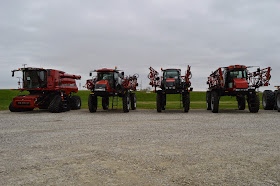 |
| 20141108 0296c |
As I turned on the side road, I noticed a locomotive headlight just down a track so I pulled into the first parking lot I found. (I took the picture when I was leaving because it caught me by surprise when I was arriving.) I found a parking lot that let me get next to the engine. But there was a tree line along the track, and the trees still had leaves even though most trees had lost their leaves.
The engine number is 6140, but I'm more interested in the railroad name. I did find a hole in the tree leaves, and by taking several shots at different angles I was able to capture most of the logo. My first guess was CGEI, then CG8. But it is CGB --- Consolidated Grain and Barge. The engine was operating a train that was servicing the grain elevator in Olney. This elevator has been on my todo list because it is a big one. The engine moved forward a little bit while I was taking pictures of the logo. So the cars were being moved forward after they were filled up.
The cars were obviously provided by CSX, and I determined that this line connects to a CSX/B&O track just a few blocks north in Olney.
 |
 |
But the Google satellite map accurately shows that the track has been abandoned back to County Road 1150 East and that the siding has been torn up except for a little engine stub at the south end. And the engine was parked on the stub.
 |
Fortunately, there was a parking lot next to the section of track that is beside the grain elevator so I was able to get a good shot of the train at the elevator.
It was obvious that the cars were provided by the CSX. In fact, I spotted the fallen flag of two Family Lines System cars.
| 20141108 0286c |
 The logo in both cars had the text GEORGIA CLINCHFIELD WEST POINT ROUTE.
The logo in both cars had the text GEORGIA CLINCHFIELD WEST POINT ROUTE.
 They have a rather large chute by the concrete silo core for filling
the cars. Note the fall protector and the two men watching the
cars fill up. This picture is at the camera's resolution.
They have a rather large chute by the concrete silo core for filling
the cars. Note the fall protector and the two men watching the
cars fill up. This picture is at the camera's resolution.Back on IL-130, I pulled into the entrance of the elevator and found myself surrounded by trucks. I decided it was a bad day to take pictures of the elevator other than to try to capture a sense of how many trucks were lined up to unload. I wanted to get pictures of all three of their ground storage structures being full, but I can get them some other day. They are not going away, the trucks are. The lineup of trucks curved around to the left and then looped back and came back across the back ground.
The entrance was near the south side of the elevator. The view below is of the north side of the elevator and shows the loop-around in the lineup of trucks.
I noticed later when looking at the pictures, that one of the ground storage units was not completely full. I wonder if they found some defective panels that could not hold grain. I don't remember this structure being used in previous years. It also occurred to me later that there was a big lineup of trucks because they are probably unloading directly into the railroad cars. The elevator probably arranged for some covered hopper cars to be delivered and put the word out to farmers that they could unload the days they were scheduled to have the cars.
I had noticed during this trip that some of the fields still had corn in them even though the harvest season seemed to be over. The corn was still in some fields because there is no place left to store the corn. So the prediction that two years of bumper crops was going to exceed the nation's grain storage capacity proved to be true.
 |
| 20150104 0101 |










.pdf%2B-%2BAdobe%2BReader.png)

































